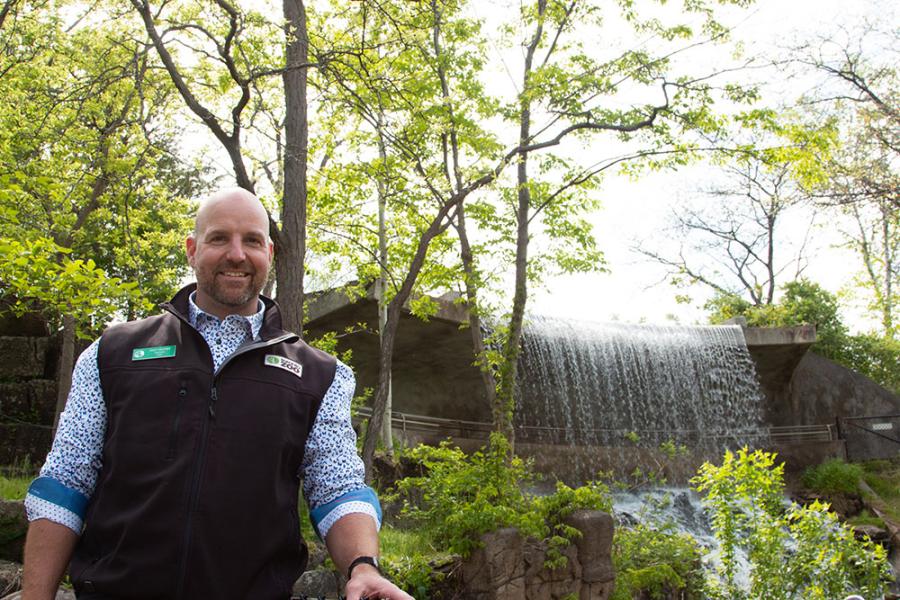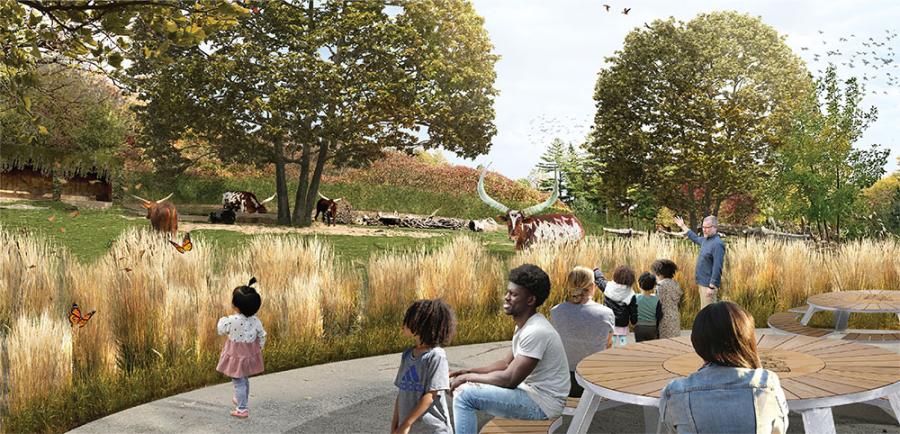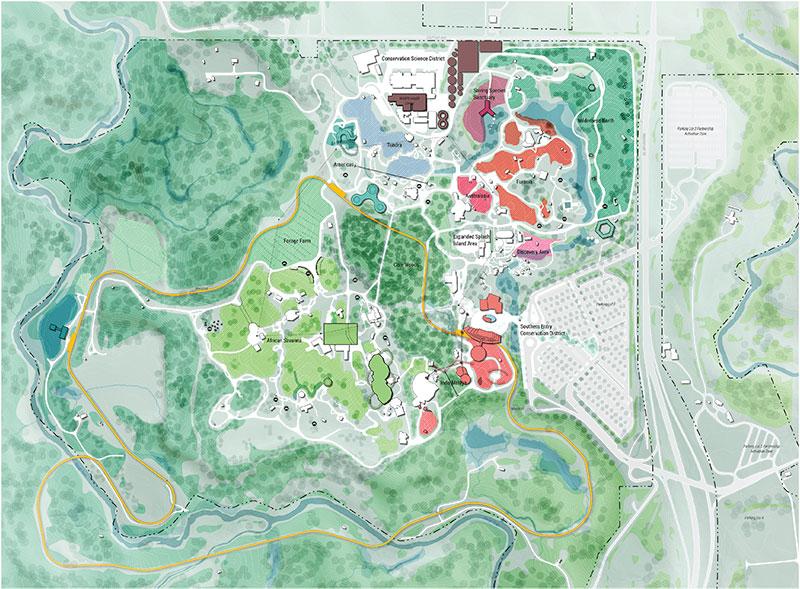Igniting Passion and Creating WOW!

When he was in the third grade, Dolf DeJong had a life-altering experience while visiting the Toronto Zoo with his mother. With wide-eyed wonder, he saw his first Sumatran tiger and other animals. It helped DeJong fall in love with nature and set him on his life’s journey; he made it his mission to connect people with the natural world. A teacher by training, DeJong has been inspiring and nurturing others to experience the same passion he feels for animals and nature. Along the way, DeJong became, as he describes it, an “accidental CEO.” He has been leading the Toronto Zoo in that capacity since 2018.
When DeJong applied for the position, he shared the anecdote about his childhood visit and its impact but then asked the interviewers why the zoo still looked essentially the same all these years later. “And would you want to change it?” he challenged them as a follow-up.
The answer, it seems, was a resounding yes.
For the past few years, the zoo has been focusing on its future, first by developing a strategic plan and more recently by rolling out a comprehensive master plan. As COVID-19 began to make inroads, the zoo closed its gates to the public in March 2020, a mere three weeks after its board approved the strategic plan. The pandemic figured prominently into the follow-up master plan, both in the ways that the process was conducted and its findings.
Over time, the plans will, in fact, help change the way the Toronto Zoo will look and the ways visitors will experience it. But just as significantly, they will provide a set of guiding principles by which capital projects will be designed and redevelopment will be approached. They will also help the organization rethink what it means to be an urban zoo in a world and society that are rapidly and dramatically evolving.
One of the largest zoos in Canada and the world, the Toronto Zoo occupies more than 700 acres and is home to over 4,000 animals, representing more than 300 species. It welcomed over 1.2 million visitors in prepandemic 2019. Surrounded by Rouge National Urban Park, the zoo is located along the Rouge River on the eastern edge of the sprawling metropolis. While there was a smaller zoo closer to the city’s core that predated it, the Toronto Zoo traces its history back to 1974, when it opened on its current site. The zoo holds a powerful, nostalgic appeal to the legions of guests who have enjoyed it over many decades.

‘Four Cares’ to Guide the Zoo
The Toronto Zoo’s strategic plan reimagines and reprioritizes the organization’s constituents. Dubbed the “four cares,” it places the lion’s share of the spotlight squarely on the animals.
Describing them as the zoo’s “sacred duty,” DeJong talks about the shifting perception of the animals. “We moved from a collections plan to an ‘animals’ lives with purpose’ plan that recognizes their conservation, education, and research outreach roles,” he says. Inherent in the reorientation is a commitment to improving the lives of the animals by doing things such as increasing their living spaces and making the areas more akin to what they would encounter in the wild.
The second “care” is the zoo’s team because it is directly involved in the welfare of the animals. Coming in third are guests. Rather than considering them only as customers and focusing on the time they spend on-site, guests are also valued as agents of change who can go out into the world and help advance the zoo’s mission. Rounding out the list is the community, which acknowledges the critical role that the zoo can and should play in the region and the interdependence between the organization and Toronto’s people and institutions.
As Jennifer Tracey, senior director of strategic communications and guest experience, points out, the zoo is located 40 minutes outside of the city’s center in one of Toronto’s most underserved, diverse, and lowest-income areas. “A visit to the zoo is not something a lot of these folks can do,” she says. As a result of the plan, the organization is working to make the zoo more accessible to all. For example, it is reaching out to settlement agencies and inviting new Canadians arriving in Toronto to visit.
“We want to create a zoo that better reflects our community,” DeJong adds, noting that he wants to ensure that guests, as well as staff, look like the city outside of the gates.
As an example of how the “four cares” might influence future developments, DeJong points to the new outdoor orangutan habitat, an approximately $10 million facility that is scheduled to open this summer. While it was conceived before the strategic plan was launched, the habitat demonstrates the lens through which projects can be viewed. With 40-foot-tall towers on which they will be able to climb as tree apes and a range of other spaces specially designed for orangutans, it’s a “very animal-centric place,” the CEO says. Additionally, it will include a research building to monitor the animals and to continue to improve their well-being.
With a built-in office for staff, the habitat will acknowledge the employees’ important role in caring for the orangutans. Guests will get to circum-navigate the building and view the animals from unique and interesting vantage points. An interpretative layer about sustainable palm oil and the product’s connection to deforestation will also provide visitors with information about how their consumer choices can have an impact on orangutans.
Moreover, the exhibit shows how the zoo’s new mission statement—connecting people, animals, and conservation science to fight extinction—will come into play. “It doesn’t actually say anything about running a zoo,” DeJong notes. The statement’s principles, however, will be firmly and cleverly embedded in the orangutan habitat.

The Pandemic was a Shot in the Arm
The 2020 plan outlines five strategic directions, the first four of which align with the “four cares,” starting with “save wildlife.” The second strategy is “ignite the passion,” acknowledging and supporting the important roles of staff members and volunteers. Focusing next on guests, the third compo-nent of the strategy is “create wow.” This includes engaging, impactful exhibits and attractions that engender fun, spark curiosity, and foster empathy.
“For every exhibit, regardless of size, we want to reach as many people as we can, educate them, and leave them wanting more,” says Leona Mitchell, director of facilities and infrastructure at the Toronto Zoo.
DeJong has a colorful way of describing “create wow.”
“I often joke about scarring people in positive ways,” he says. “We want to leave marks on them that last a lifetime.”
The fourth strategy, “our community and our zoo,” recognizes the strands that connect the organization’s local, regional, and global audiences, while the final strategy, “revolutionize zoo technology,” focuses on the ways that innovation can enhance the zoo experience and operations. For example, the orangutan habitat will incorporate camera technology, machine learning, and artificial intelligence to monitor the primates’ behaviors in tandem with staff observation. The system will be smart enough to tell the orangutans apart from one another.
The final two strategies, community and technology, proved to be key as the pandemic unfolded. With the crisis forcing the issue, the zoo introduced technology-based solutions, such as a health check screening app for staff and thermal scanners to screen for fever. The zoo temporarily closed, but its community grew as the organization found its voice online. It attracted over 900,000 fans and followers, more than tripling its social media audience. As an example of their active engagement, supporters donated almost $1 million to the “Zoo Food for Life” campaign.
“In some ways, I’m grateful for the pandemic,” Tracey says. She explains that the organization used the downtime to become more innovative and dynamic and to craft a revised master plan that acknowledges the new reality. Rather than holding a physical open house or employing other in-person methods, it turned to its newly energized online community for public input. “We had over 3,000 digital responses to our lengthy, comprehensive survey,” Tracey marvels. “It was very unique and powerful.”
To coordinate the master plan process, the zoo partnered with Mandaworks, a design studio and planning consultancy. According to Leslie Norris, landscape designer at Mandaworks, it was challenging for the company to get a sense of the zoo when it conducted site visits during the pandemic since there were no guests present. Also, it was difficult soliciting the input of the most important audience.
“The animals who live at the zoo are a tricky set of stakeholders to craft a vision around,” Norris says with a laugh.
Nevertheless, Mandaworks helped create a road map that will guide the zoo from the foundation established in its strategic plan to the actions it will need to take as it embarks on projects and reimagines itself. Taking issues such as climate change, habitat loss, and species extinction into consideration, the plan will enable the organization to tackle existential concerns.
“What is the place of a zoo today and moving into the future?” Norris asks. “What will it mean to be a zoo, period? We kept going back to these questions.”
The 2022 master plan includes characteristics to which the zoo can aspire, including “nimble,” which was partly inspired by the COVID-19 crisis. When it couldn’t allow guests to visit in the conventional way, for example, it quickly developed a drive-thru zoo program that enabled visitors to experience the animals from the safety of their cars.

Dynamic New Spaces and Experiences
Another characteristic—“all day, all week, four seasons, forever”—encourages the zoo to move away from its peak days model, which attracts huge crowds for a few hours on select days, and instead optimize the shoulder season, evenings, and other underutilized periods. For instance, the zoo is planning to build an indoor savanna, which will host rhinos and other animals. The new facility would make the zoo more accessible year-round, especially during Toronto’s chillier months.
“Having these animals viewable in winter is a huge benefit for the animals, our guests, and us,” says Mitchell. “It also will present other opportunities, such as event space and restaurant space.”
Some of that restaurant space might be designed as higher-end dining experiences, she adds. It’s a bid to expand beyond the zoo’s key demographic, families with young children, and appeal more to millennials, boomers, and other audiences. To that end, the zoo launched “Terra Lumina,” an immersive, nighttime experience that features vibrant lighting, multimedia effects, and video projections along a 1.5-kilometer walking path. The zoo obtained a site-wide liquor license to enhance its events and activities.
Tracey adds that the zoo is also considering the addition of a hotel. It might be part of a conservation campus that is being planned as a revamped front gate. The project would include an outdoor otter habitat, conservation program facilities, and classrooms and meeting spaces that would be made available to the public—part of the zoo’s bid to be more of a community hub.
The master plan also calls for the addition of a day care program. In addition to providing a much-needed community resource, the program would give young children an incredible opportunity to interact with, learn about, and gain appreciation for animals.
For third graders visiting the Toronto Zoo when it celebrates its 50th anniversary in 2024, DeJong hopes that they will have the same kind of life-changing experience that he had as a child. But he also hopes that they come away with more from the reimagined zoo.
“They will get excited about the future we are trying to create for nature,” DeJong says. “They will see some amazing things, and then they will realize, ‘Wait a second. There’s more that I need to be doing in my day-to-day life to help animals. I’m part of this community, and together we can achieve that.’”
- Arthur Levine has been covering the attractions industry for decades. He authors Funworld’s “The Art of Attractions” column and produces his own Substack newsletter, “Arthur’s About Theme Parks.”
